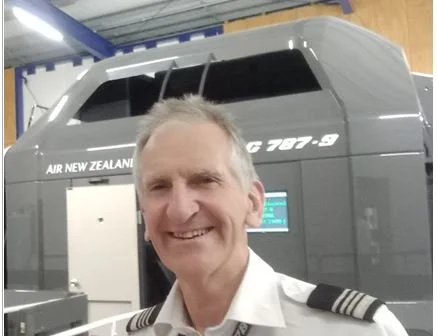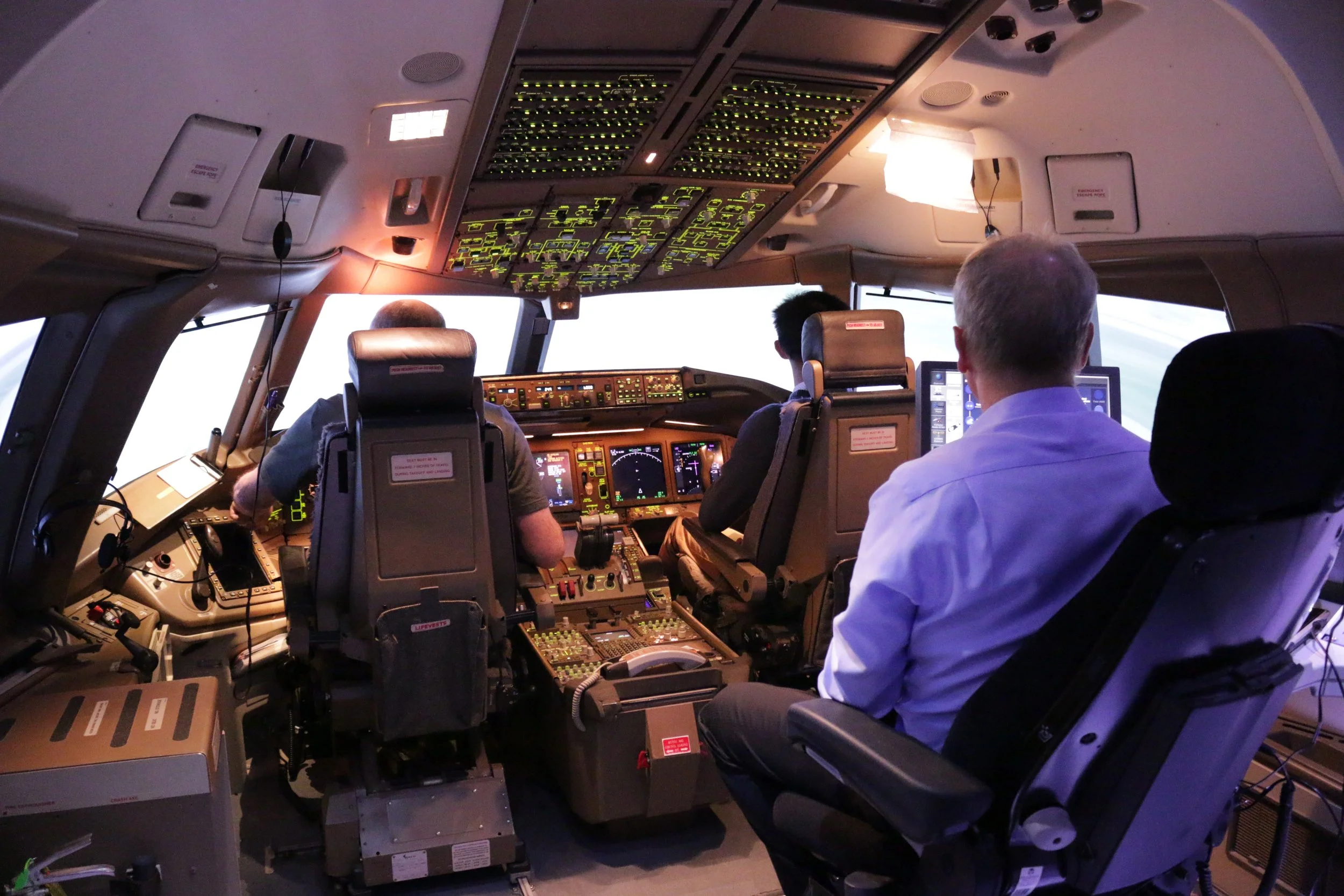ZERO FLIGHT TIME (ZFT) FLIGHT SIMULATORS Arthur Gatland
In the interesting old days of low tech flying, a pilot who moved from aircraft type to aircraft type had to learn about the new type in a class room then head out and actually fly the empty behemoth around and around in circuits completing touch and go’s at an airport - keeping out of the way of scheduled air services operating in the same airspace.
This was the way Air New Zealand crew learned how to operate the aircraft types in the fleet, right up to 1990s. For John, he first encountered a ZFT simulator when he moved, as Captain, from the B767 to the B777. Every moment of his conversion course flight time was completed on the simulator. In fact, the first time he ever set foot in a real B777 was on his first duty flying it across the Tasman, with passengers.
He felt the transition from simulator to actual flight deck was seamless. He didn’t feel there was the slightest difference in handling between the two.
Captain Arthur Gatland is a current B787 simulator instructor in Auckland and here he gives us a run down on the history of Air New Zealand’s ZFT simulators and what makes them so capable. As usual, Air New Zealand was a world leader in embracing the new technology and Arthur spoke at international conferences about the benefits to airlines to use these simulators.
Over to you, Arthur.
Captain Arthur Gatland and his beloved B787 Sim
Zero Flight Time Training (ZFTT) refers to the training given on an aircraft type rating course that is carried out entirely in a suitable flight simulator. Use of the type rating may be restricted to the approved airline until line flying under supervision has been accomplished.
Air New Zealand purchased its first ZFT flight simulator for the 1990 introduction of the Boeing 747-400. Since then, flight simulators purchased for the Airbus A320, Boeing 777 and Boeing 787 are all ZFT.
What makes a flight simulator ZFT approved?
A Level D/Type 7 simulator must accurately simulate all aircraft systems that are accessible from the flight deck and are critical to training. In particular, pilot flight controls must have accurate force feedback provided through "control loading", and other systems such as avionics, communications and glass cockpit displays – or Head-up Display (HUD) - are also realistically simulated. A Level D/Type 7 FFS also provides excellent motion feedback to the crew through a motion platform upon which the simulator cabin is mounted. The motion platform must produce accelerations in all of the six degrees of freedom (6-DoF) that can be experienced by a body that is free to move in space, using a principle called acceleration onset cueing.
Melissa here - Six degrees of freedom (6DoF) refers to the six independent ways a rigid body can move in three-dimensional space: three translations (forward/backward, up/down, left/right) and three rotations (yaw, pitch, roll).
B787 ZFT Simulator
For a ZFT simulator, a realistic visual display is critical. Visual systems of full flight simulators are typically based on the cross-cockpit collimated display concept, in which the computer-generated out-the-window view is projected on the back of a translucent screen. The image that forms on the other side is then reflected by a curved mirror that extends around the entire cockpit, providing a field of view that can reach 200° horizontally and 40° vertically. The collimating design of the mirror gives the occupants a realistic impression of three-dimensionality when looking at distant objects. Visual displays have improved dramatically in recent years as computer technology improves. For example, a visual display can be adjusted with windscreen wipers turned on in rain, and shows reflections of parked aircraft on wet tarmac etc. Shadows are accurately presented etc., all changing as you taxi past in your “aircraft”. Of course, any weather condition can be accurately displayed, from summer cloud to winter conditions with drifting snow or ice patches, fog, various types of precipitation and of course wind and turbulence as required.
This standard of flight simulator is used both for initial and recurrent training for commercial air transport aircraft. Initial training is for conversion to a new aircraft type, and recurrent training is that which all commercial pilots must carry out every six months to retain their qualification to fly fare-paying passengers in passenger aircraft (under CAA Rules Part 121).
The Boeing 767 was the last wide-body aircraft in Air New Zealand that was not supported by a ZFT simulator. As a result, when pilots were trained to operate the B767 they completed a type-rating course of classroom, procedures trainer and flight simulator training – followed by circuit flying in the aircraft. The latter was usually carried out at Ohakea or Christchurch (very occasionally at Auckland, but this was significantly disrupted by scheduled arrivals and departures which had priority over circuit training.)
Inside the Simulator. the operating crew at the front and the Sim Instructor at his station with his array of Sim controls and computers
Prior to the 2003 introduction of the Airbus A320 into Air NZ, a small group of Managers and flight instructors had several meetings with Airbus in Toulouse, France, and we attended a few Airbus Operators conferences, for example in Seville, Spain. Of course, we were already using a ZFT (zero-flight time) simulator, but as we found out we were ahead of many other airlines in this area. Apparently we were the first Airbus operators to do this. Airbus were planning to use ZFT simulators for A320 introduction, also looking ahead to the A380 aircraft. At the Seville Conference, Airbus asked me to briefly speak about the use of ZFT flight simulators – to help them sell the ZFT concept to sceptical operators.
After I had enthusiastically described ZFT training, a few airlines asked questions – including a few surprising ones… “When you do engine failure training in the simulator, do you just bring the thrust lever back to idle as you would with aircraft training?” No of course not, you make it fail completely like it might in real life. That’s the beauty and realism of flight simulators, and there’s no risk to a real aircraft. This seems totally obvious today, but even in 2003 it was a revelation to some airlines.
Obviously, apart from the cost of circuit training, there are risks in circuit training if engine failures or other faults are simulated. Several examples include an Air New Zealand DC-8 at Auckland in 1966, when the instructor attempted to simulate an outboard engine failure just after take-off but inadvertently selected reverse thrust, with disastrous consequences.
Apart from realism when simulating emergencies such as an engine failure, hydraulics failures, airspeed errors or flight control issues, very modern flight simulators are programmed to more accurately represent flight characteristics outside the normal flight envelope. For example, stall recovery training has been taught as a standard exercise for many years, and of course recovery is initiated at the first symptom of an impending stall. However there are several examples of accidents where pilots found their aircraft outside the normal flight envelope, such as in a deep stall, and apparently did not have the knowledge or ability to recover (eg. Air France 447 into the Atlantic Ocean). With modern ZFT simulators, Upset Prevention and Recovery Training (UPRT) could include training to recognise and recover from a similar deep stall.
All flight simulators are required to undergo Fidelity Checks throughout any year, to ensure they maintain the correct systems function and flying characteristics of the real aircraft. This is obviously critical with ZFT simulators.
These flight simulators cost over USD $20 million but are still very cost-effective to replace training in the real aircraft, apart from being able to provide realism in emergency situations which would be impossible (or unwise) to simulate in the real aircraft.
Thanks Arthur. And now for some videos. Arthur has kindly provided some footage from inside the Sim for a takeoff and another showing the same take off (and landing) from the outside so we can see how the sim operates. We even have Arthur giving commentary on the outside view.
So here is the first video - a takeoff and left hand turn - have a giggle at the kiwi accent on the aircraft warning….
Simulator Take off
And here’s the second video from outside the unit. Watch for some impressive braking action at the end of the flight!
The impressive actions of a ZFT Simulator
And for those who’d like to enjoy what Arthur can do in the B787 Sim - watch this remarkable video of Arthur taking only a minute from take off roll to then land again at Auckland Airport - you’ll get to hear practically every alarm the flight deck has! 🫣😁
And since it is Easter with yukky weather forecast for most of us, here’s a chance to get to know Arthur - he has had one of the best aviation careers we have ever encountered - from cold war shenanigans for the RAF, to gliding, to commercial aviation (even turning a passenger filled F27 into a glider - just because he could), you can read his stories in this set of blogs …
https://www.pauwelsflyingscholarship.co.nz/blog/a-lifetime-in-aviation-arthur-j-gatland
https://www.pauwelsflyingscholarship.co.nz/blog/raf-hunter-and-hawk-flying-by-arthur-gatland



